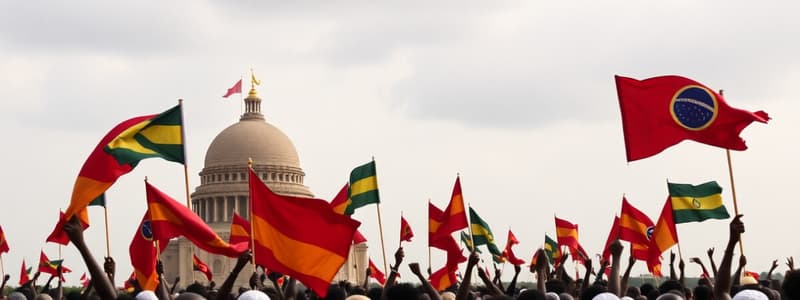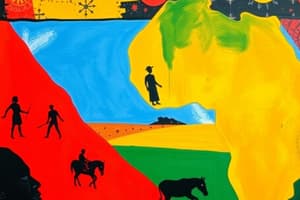Podcast
Questions and Answers
Which of the following is NOT a determinant of population growth or decline?
Which of the following is NOT a determinant of population growth or decline?
- Death rate
- Birth rate
- Income level (correct)
- Net migration
The Neo-Malthusian view strongly supports the idea that population growth can lead to resource depletion.
The Neo-Malthusian view strongly supports the idea that population growth can lead to resource depletion.
True (A)
What term describes a person who moves from one country to another seeking refuge from persecution?
What term describes a person who moves from one country to another seeking refuge from persecution?
Asylum seeker
The __________ is the difference between the number of births and deaths in a population, often expressed as a percentage.
The __________ is the difference between the number of births and deaths in a population, often expressed as a percentage.
Match the following terms related to migration with their definitions:
Match the following terms related to migration with their definitions:
What was a primary consequence of the Berlin Conference in the 1880s?
What was a primary consequence of the Berlin Conference in the 1880s?
Pan-Africanism aims to unify African nations and people globally.
Pan-Africanism aims to unify African nations and people globally.
Name two components of the Human Development Index (HDI).
Name two components of the Human Development Index (HDI).
The __________ Theory divides countries into core, semiperiphery, and periphery based on their economic development.
The __________ Theory divides countries into core, semiperiphery, and periphery based on their economic development.
Match the development theory with its key characteristics:
Match the development theory with its key characteristics:
Which of the following best describes the economic activity levels in a high-income country?
Which of the following best describes the economic activity levels in a high-income country?
Climate change is primarily caused by natural factors, not human activities.
Climate change is primarily caused by natural factors, not human activities.
What does NDC stand for in the context of the Paris Agreement?
What does NDC stand for in the context of the Paris Agreement?
Flashcards
What was the Scramble for Africa?
What was the Scramble for Africa?
The Scramble for Africa was a period of intense colonial competition among European powers in the late 19th century. It resulted in the division of most of Africa into European colonies, ignoring existing ethnic boundaries and cultural differences, often leading to conflict and instability.
What was the Berlin Conference?
What was the Berlin Conference?
The Berlin Conference of 1884-1885 was a meeting of European powers to regulate colonization and trade in Africa. They carved up the continent without consulting African leaders, leading to artificial borders and ongoing conflict.
What is Modernization Theory?
What is Modernization Theory?
Modernization Theory suggests that societies progress through stages of development, from traditional to modern, with economic growth as the key driver. It emphasizes Westernization and argues that developing countries can follow the path of developed nations. However, it faces criticism for ignoring colonial legacies and disparities.
Explain World Systems Theory.
Explain World Systems Theory.
Signup and view all the flashcards
What is climate change?
What is climate change?
Signup and view all the flashcards
What is the Paris Agreement?
What is the Paris Agreement?
Signup and view all the flashcards
What is climate change adaptation?
What is climate change adaptation?
Signup and view all the flashcards
What is climate change mitigation?
What is climate change mitigation?
Signup and view all the flashcards
Birth Rate
Birth Rate
Signup and view all the flashcards
Death Rate
Death Rate
Signup and view all the flashcards
Net Migration
Net Migration
Signup and view all the flashcards
Emigrant
Emigrant
Signup and view all the flashcards
Immigrant
Immigrant
Signup and view all the flashcards
Study Notes
Colonization and Independence in Africa
- Elmina Castle in Ghana: Changed function and meaning over time, reflecting changes in power dynamics.
- European Rationalization of Colonialism: Motives included competition, fear, and exploitation. Fueled by factors such as Europe's population explosion and capitalism.
- Berlin Conference (1880s): Led to the "Scramble for Africa," with European powers dividing the continent.
- Impacts of European Colonial Rule: Superimposed borders, economic exploitation, and political control.
- World Wars (WWI and WWII) and Africa: Colonized Africans often fought in wars, contributing to the independence movement.
- Anti-Colonial Resistance Movements: Led to independence movements throughout Africa.
- Pan-Africanism: Advocated for unity and cooperation among African nations.
Economic Development
- Levels of Economic Activity: Primary, secondary, tertiary, and quaternary sectors.
- GDP, GNP, GNI per capita: Indicators used to measure a country's economic output per person.
- Human Development Index (HDI): Measures a country's well-being beyond economic output. Components include health, knowledge, and a decent standard of living.
- HDI and other factors: Correlation between HDI, gender equality, and fertility rates.
- Theories of Economic Development:
- Industrial Revolution: Historical context for economic growth.
- Racial Capitalism: Economic systems built on racial hierarchies.
- Economies of Extraction: Focus on resource extraction for profit.
- Modernization Theory: Five stages of development; criticized for its Western-centric view.
- World Systems Theory: Core, semi-periphery, periphery - divides the world into economic zones and explores neocolonialism. Criticized for its broad generalizations about global economic structures.
- Debt: A significant economic challenge for many countries.
Climate Change and Environmental Factors
- Factors Affecting World Climates (LACEMOPS): Latitude, air pressure, cloud cover, elevation, wind, and ocean currents influencing weather patterns.
- Latitude and Climate Zones: Low (tropical), mid (temperate), and high (polar/arctic) latitude zones and their prevailing climates.
- Climate Change Causes: Human activities like burning fossil fuels are a major contributor.
- Countries Most Responsible for Climate Change: Discussions on emissions and responsibility.
- Carbon Emissions: Climate change impacts and sources.
- Climate Change Adaptation and Mitigation: Examples of actions to adapt to and mitigate climate change.
- Climate Justice: The fair distribution of resources and burdens related to climate change.
- Paris Agreement: International accord to limit global warming by reducing greenhouse gas emissions.
- Nationally Determined Contributions (NDCs): Nationally set targets for emissions reduction.
- How to read latitude and longitude
Population and Migration
- Global Population Trends: Falling fertility rates worldwide.
- Fertility Rates in Developed vs. Undeveloped Countries: Higher in developing, lower in developed.
- The Top Ten Most Populous Countries (2022): Understand the concept of population rankings.
- Population Growth Determinants: Birth rate, death rate, and net migration.
- Demographic Transition Model: Stages of population change and why they occur.
- Key Population Definitions: Birth rate, death rate, net migration, emigrant, immigrant, rate of natural increase, total fertility rate, replacement fertility rate, life expectancy, and dependency ratio.
- Population Pyramids: Expansive, stationary, and constrictive types.
- Migration: Analyzing migration flows, push and pull factors.
- Intervening Obstacles: Factors hindering migration (economic, social, political, and environmental).
- Remittances: Money sent home by migrants.
Colonialism, Economic Development, and Global Trade
- Settler Colonialism: Conquest of Native American lands; Warfare, treaties and violations including removal.
- Definitions: Empire, imperialism, polity, colony, hegemony, settler colony (example), administrative colony (example).
Studying That Suits You
Use AI to generate personalized quizzes and flashcards to suit your learning preferences.




